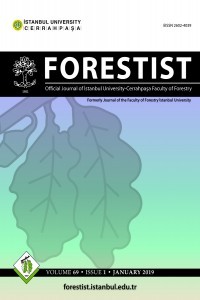Tenggaroh-Malezya ormanındaki farklı sıklıkta Shorea peltata sym. altında toprak solunumu ve karbon dinamiği
Bu çalışma, Malezya Tenggaroh Ormanı’nda gerçekleştirilmiştir. Çalışmanın amaçları, farklı sıklıktaki Shorea peltata sym. altında toprak solunumunun araştırılması, toprak solunumu ve toprağın fiziksel ve kimyasal özellikleri arasındaki ilişkinin belirlenmesidir. Yirmi adet 50x50 m boyutunda (E1) nadir, (E2) düşük, (E3) orta ve (E4) yüksek sıklıkta deneme alanları oluşturulmuştur. Her deneme alanında 25 alt parsel ayrılmıştır. Toprak solunumu LCpro+ cihazı ile 0-6 cm derinlikte ölçülmüştür. Toprak solunum ve karbon dinamiklerinin sonuçları gruplar arasında P
Anahtar Kelimeler:
Toprak solunumu, karbon dinamiği, Shorea peltata sym., toprak sıcaklığı, azot, mevcut kükürt
Soil respiration and carbon dynamics under different densities of Shorea peltata Sym. in Tenggaroh Forest Reserve, Malaysia
Soil respiration and carbon dynamics under different densities of Shorea peltata Sym. in Tenggaroh Forest Reserve, MalaysiaAbstract: A field experiment was conducted in Tenggaroh Forest to compare soil respiration and carbon dynamic under different densities of Shorea peltata. The objectives of this study were: to investigate soil respiration under different site characteristics of Shorea peltata and to determine the relationship between soil respiration and soil physical properties. Twenty observational plots 50x50 m namely, rare (E1), low (E2), moderate (E3) and high (E4) were established. Each plot was divided into 25 subplots. Five subplots were selected randomly. Soil respiration characteristics were recorded used LCpro+ instrument at 0 to 6 cm depth. The results of soil respiration and carbon dynamics showed significant differences at P<0.05 among the groups. Analysis for the relationship between soil respiration and site variables (correlation) showed that the soil temperature, total of carbon, total of nitrogen and available of sulphur were the important factors in the distribution of vegetation in study sites.Keywords: Soil respiration, carbon dynamics, Shorea peltata sym, soil temperature, nitrogen, available sulphur
Keywords:
Soil respiration, carbon dynamics, Shorea peltata sym., soil temperature, nitrogen, available sulphur,
___
- Ashton, P.S., 1998. Dipterocarpaceae. In E. Soepadmo,L.G. Saw,and R.C.K. Chung (Eds.). Tree Flora of Sabah and Sarawak. Government of Malaysia, Kuala Lumpur, Malaysia.
- Bachman, R., Paternoster, R., 1997. Statistical Methods for Criminology and Criminal Justice (2nd ed.) New York:
- MCGraw-Hill Company. Buchman, N., 2000. Biotic and abiotic factors controlling soil respiration rates in Picea abies stands. Soil Biology and Biochemistry 32: 1625-1635.
- Butler, R., Laurance, W., 2008. New strategies for conserving tropical forest. Trends in Ecology and Evolution 23: 469-47 Dayanandan, S., Ashton, P.S., Williams, S.M., Primack, R.B., 1999. Phylogeny of the tropical tree family Dipterocarpaceae based on nucleotide sequences of the chloroplast RBCL gene. American Journal of Botany 86: 11-82.
- Dennis, E.H., William, W., Stephen, G.J., 2002. Applying statistical concepts. In P.R. Anant (Ed.). Applied Statistical for the Behavioral Sciences (pp. 5-10). USA: New York, Houghton Mifflin Harcourt.
- Dong, Y., Scharffe, D., Lobert, J.M., Crutzen, P.J., Sanhueza, E., 1998. Fluxes of CO2, CH4 and N2O from a temperate forest soil, the effects of leaves and humus layers. Tellus 50: 243-252.
- Fierer, N., Allen, A.S., Schimel, J.P., Holden, P.A., 2003. Controls on microbial CO2 production, a comparison of surface and subsurface soil horizons. Global Change Biology 9: 1322- 1332.
- Fujiwara, K., 1987. Aims and methods of phytosociology of vegetation science. Plant Ecology and Taxonomy 5: 606-628.
- Keller, M., Kaplan, W.A., Wofsy, S.C., Dacosta, J.M., 1988. Emissions of N2O from tropical forest soilsand response to fertilization. Journal of Geophysics Research 93: 1600-1604.
- Başlangıç: 1951
- Yayıncı: İstanbul Üniversitesi-Cerrahpaşa
Sayıdaki Diğer Makaleler
Sandıras Dağı'ndaki (Muğla) yaşlı karaçam ormanlarından dört yeni yıllık halka kronolojisi
Gövde kusurları optimum boylama metodunun başarısını nasıl etkiler?
Abdullah Akay, Hasan Serin, Mehmet Pak
Armin MASHAYEKHAN, Hamid JALİLVAND, Mohamad POURMAJİDİAN, Mohamad GHOLAMİ, Mojgan TEİMOURİ
Orman-Oraman etimolojisi üzerine
Musalam ABDALMOULA, Mohamad ALİAS, Mohamad HAMZAH, Ahmad NURUDDİN
Üretim işlerinin planlanmasında RTK-GPS tabanlı sayısal yükseklik modelinin kullanılması
Neşe GÜLCİ, Abdullah AKAY, Orhan ERDAŞ, Sercan GÜLCİ
Ahşap çimento kompozit tuğlalarında güçlendirici olarak ahşap atıklarının kullanılması
